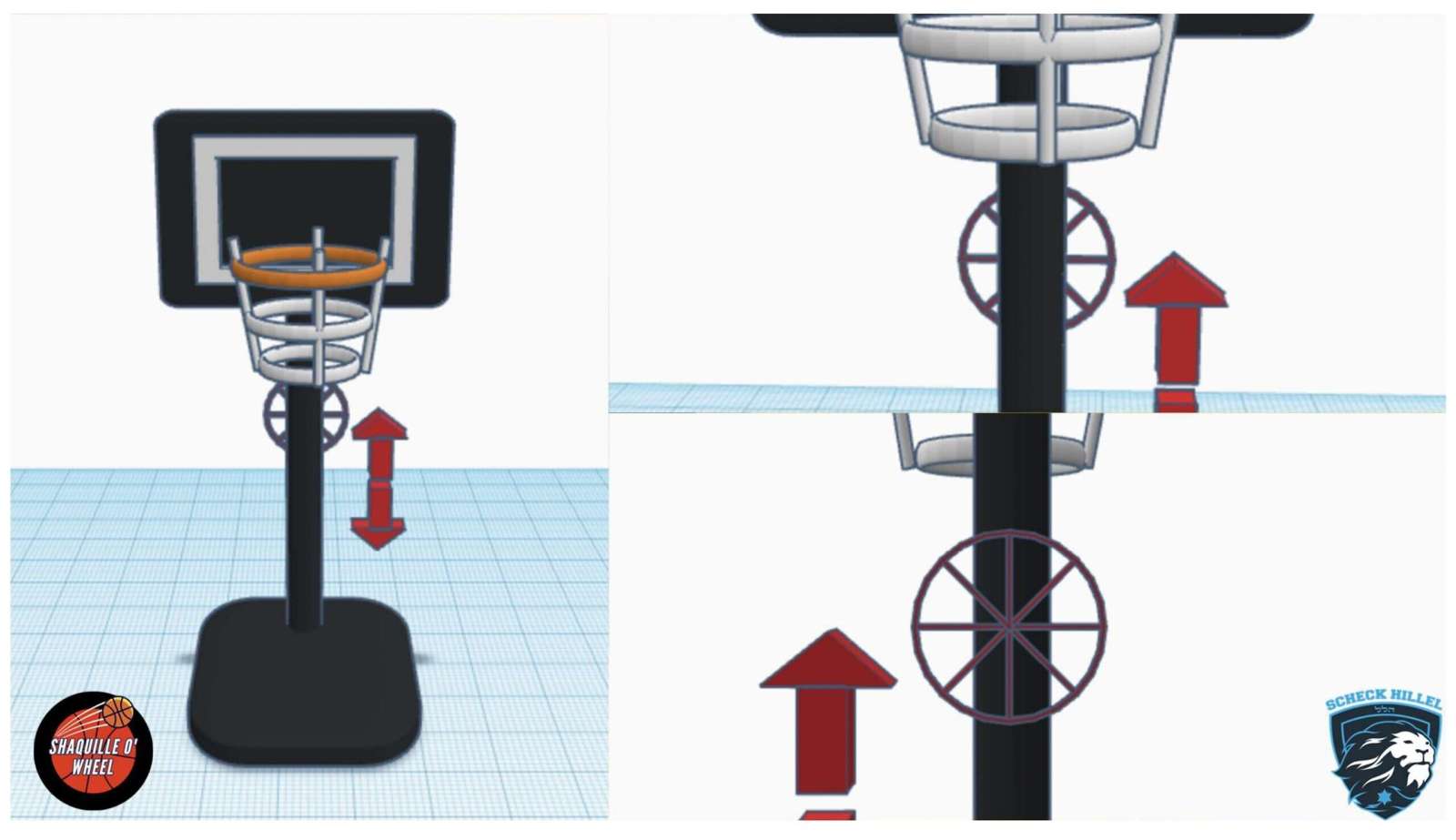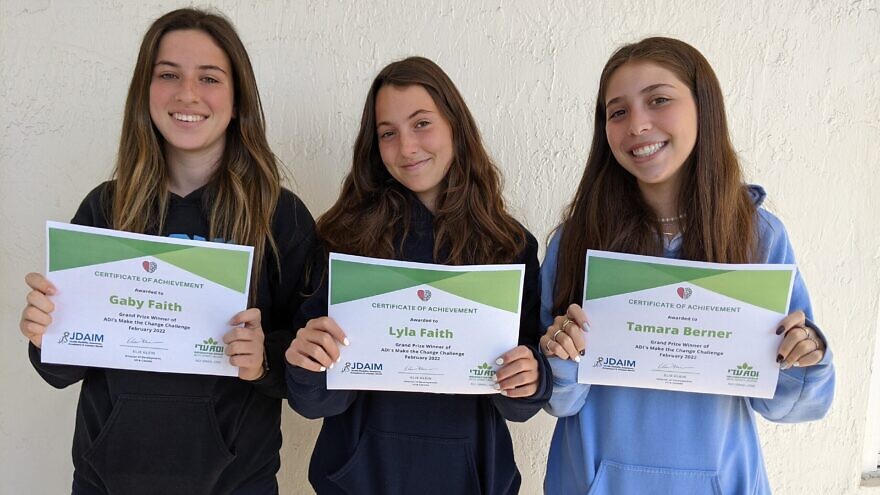What new invention is named after a member of the Naismith Memorial Basketball Hall of Fame, inspired by Israeli disability care and advancement organization, and designed by North American Jewish day-school students?
It’s the “Shaquille O’ Wheel,” a reimagined basketball hoop that makes it easier for people using wheelchairs and others to adjust the height of the hoop by simply turning a wheel. Designed by Lyla Faith, Gaby Faith and Tamara Berner—eighth-graders from the Scheck Hillel Community School in Miami—it was the winning design among 180 entries from students across North America in ADI’s “Make the Change Challenge” STEM accessible design contest.
“I am extremely proud of the hard work the girls put in and the success they achieved,” Elana Lazar, Design/STEM Department chair and teacher at Scheck Hillel, told JNS. “But I also reinforce to my students that it’s about the process rather than the end product, at this stage of their life especially. Maybe that wasn’t the first version of the design, or it didn’t become a big hit on [the TV show] ‘Shark Tank,’ but they can still be successful.”
Now in its second year, the “Make the Change Challenge,” which marked February’s annual Jewish Disability Awareness, Acceptance and Inclusion Month (JDAIM), encourages students to hack the modern world by creating new devices and improving existing ones in an effort to help people with disabilities overcome the challenges that hinder their independence and inclusion. Besides the Shaquille O’ Wheel, some of this year’s notable entries included a baby monitor that alerts deaf parents to their child’s needs by shaking their mattress; “computer specs” that help individuals with selective mutism navigate social situations; a wheelchair that emits a special plaster to fill a dangerous crack in the sidewalk; and a handheld system that allows a blind person to use a Braille slider to print letters in the recognized English alphabet.

Elie Klein, ADI’s director of development for the United States and Canada, called the “Make the Change Challenge” the “crown jewel” of “ADI Bechinuch”—the organization’s initiative that provides elementary, middle and high schools with entertaining and engaging modules, including disability simulations and a host of multimedia resources, that teach students about the realities of disability and highlight the importance of inclusion. For the challenge, partner schools research and develop original accessible design ideas from November through February. In addition to the team from Scheck Hillel, this year’s top five entries included designs from students at Donna Klein Jewish Academy in Boca Raton, Fla.; David Posnack Jewish Day School in Davie, Fla.; Bialik Hebrew Day School in Toronto; and the Ramaz School in New York City.
“In fact, several partners, including Scheck Hillel and the Ramaz School in New York City, have made the contest a central component of their STEM curriculums,” said Klein. “Our in-class activities, virtual tours and STEM contest encourage the next generation of Jewish leaders to be thoughtful, sympathetic and see the world through the eyes of others, and this talented trio’s game-changing design is proof that our young leaders are really connecting with our ADI Bechinuch programming, using their hearts and minds to consider the experiences of others.”
Gabrielle Gononsky, design thinking specialist N-8 at Ramaz, said the school is “always looking for projects that are not just about what’s in the here and the now, but what has greater impact. [The challenge] was a great opportunity for us to work as a team.”
“Kindness, awareness and tikkun olam (‘repairing the world’) are really embedded in the fiber of the school, but this is also a rare opportunity to have a class that takes those principles and applies them with hands-on thinking,” she told JNS.
Lazar said Scheck Hillel framed the challenge for students by posing the question, “How would I do this if … ?” In a problem-solving process, they sought to determine how they could go about a task or activity without capabilities such as seeing, walking or throwing. It aligned with the existing creative-design process in the school’s STEM program, which involves researching, developing ideas and building solutions.
Scheck Hillel had previously partnered with ADI for several years on different chesed (kindness and community-service-related) activities, as the school has a tikkun olam unit in place that facilitates students’ participation in such initiatives.
“This is showing them how innovation really fits into our Jewish values and perspective, and how we help everyone. It’s not only Jews helping Jews … this is lending a hand beyond your circle,” said Lazar.
‘Bringing lofty ideas down to earth’
On Feb. 27, ADI’s panel of experts, innovation journalists and specialists in the field of accessible design met with the top five finalists, as well as their parents and teachers, via Zoom to discuss the entries in greater detail. The designers of the Shaquille O’ Wheel received a $1,000 grand prize, a gift from the Avraham and Esther Klein Young Entrepreneurs Fund.
“I hope that these girls will take this innovative experience with them as their journey continues,” Lazar said of the contest winners from her school. “At Scheck Hillel, we are proud to have so many females active in design/STEM courses both in middle and high school, and continuing on to pursue degrees in various STEM fields.”
ADI, according to its stated mission, “provides the highest-level rehabilitative care for all and is laying the groundwork for the establishment of fully inclusive communities across the country.”
“Though our ADI centers are located in Jerusalem and the Negev, our ADI Bechinuch programming allows us to promote disability inclusion, equity and access around the world, and do our part to ensure that every community has tangible opportunities for encountering disability, raising awareness and promoting acceptance,” said Klein. With the “ingenious innovations” designed in the “Make a Change Challenge,” he added, “we are creating real awareness and encouraging a societal shift towards true inclusion.”
Klein told JNS that after running ADI Bechinuch programming in Israel for several years, the organization realized that it had “created something very special, and that it was our responsibility to share it with communities around the world. North America seemed like the perfect place to start because so many Jewish schools in the U.S. and Canada were actively searching for this kind of programming to enhance their existing curriculum.”
“We were blessed to find wonderful partner schools up and down the East Coast of the United States and in Canada who immediately added our ADI Bechinuch programming to their educational calendars during JDAIM and throughout the school year,” he said. “Within just a few weeks of implementing the programming, educators began to notice a change—their students were becoming more empathic, asking thoughtful questions about disability, and looking for opportunities to volunteer with the disability community and make a difference in their own communities.”
The “Make the Change Challenge” focuses on accessible design, said Klein, “because it’s a tangible representation of real disability awareness.”
“It’s a way of bringing these lofty ideas down to earth and demonstrating how we can make an immediate impact,” he said. “We can only make a change when we recognize the overall inaccessibility of our world—that our public spaces and mass-produced products were not built and developed with everyone in mind. While the goal is to create an accessible world, the first step is figuring out how to make what is currently available to us more universally user-friendly. The more we engage in this pursuit, the quicker we will graduate from retrofitting to actually designing for everyone.”


























